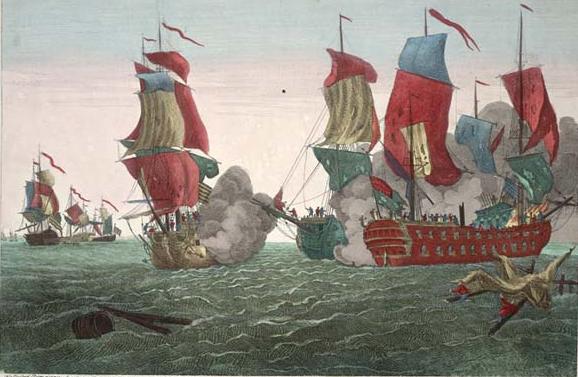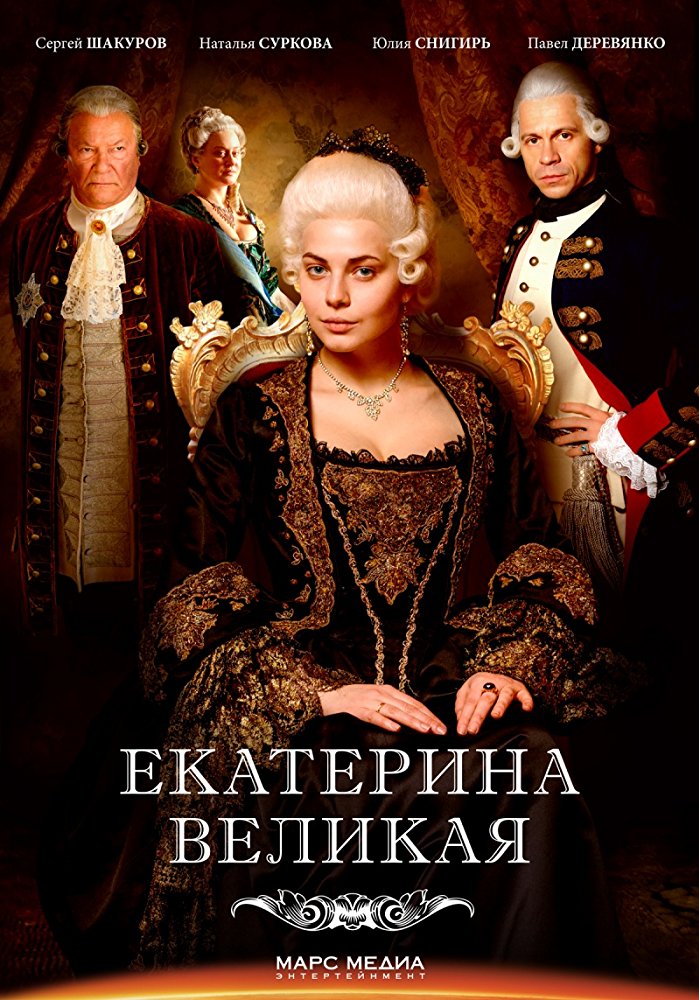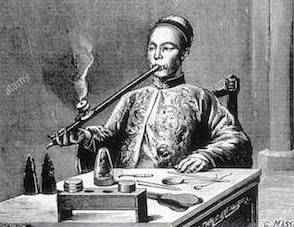
September 23, 1779 – Battle between Bonhomme Richard and Serapis, off Flamborough Head…
* * * *
Here’s a break in the action from way too many political posts…
This past Saturday morning I ran across my paperback copy of John Paul Jones: Sailor, Hero, Father of the American Navy, by That reminded me of a post I did back in June 2016, On John Paul Jones’ CLOSEST call. The “CLOSEST call” part had to do with Jones being accused of raping a 12-year-old girl.
But the really strange part came in finding out that – at the time – Jones was serving in the Russian navy. And here we’ve been told all along that he was the Father of the American Navy. So first a word about this better-known aspect of John Paul Jones.
That is, most people know John Paul Jones as the American naval hero of the Revolution.
 That included his signal victory over the British man-of-war HMS Serapis, in the Battle of Flamborough Head, seen at right. Jones commanded the Bonhomme Richard, “originally an East Indiaman.” That is, it was a merchant ship that had been jury rigged into an ad hoc Navy vessel.
That included his signal victory over the British man-of-war HMS Serapis, in the Battle of Flamborough Head, seen at right. Jones commanded the Bonhomme Richard, “originally an East Indiaman.” That is, it was a merchant ship that had been jury rigged into an ad hoc Navy vessel.
As a result of that hours-long battle, the Bonhomme Richard sank, and Jones had to make the captured Serapis his new flagship. But in the latter part of the battle he is supposed to have said, “I have not yet begun to fight.” That was said to happen when the commander of the Serapis called out, asking Jones if he was ready to “strike the colours;” i.e., to surrender.
” And in his official report, Jones merely said he had answered “in the most determined negative.” Which is definitely not as colorful, but we digress…
Back to why Jones joined the Russian navy.
The Revolutionary War ended in 1783, but as late as 1787 – four years later – Jones was still trying to get the prize money due him from the war. (He was growing increasingly disgruntled with the American Congress. “Go figure!”) Accordingly, he decided to leave the country and enter the service of the Empress Catherine II of Russia. She commissioned him a rear admiral, and so he was known in the Russian Navy as “Kontradmirál Pavel Dzhones.”
For more on why he ended up an admiral in the Russian navy, see John Paul Jones – Russiapedia Foreigners in Russia. For one thing, in 1785 the U.S. banned privateering. That was the practice of a non-naval ship – and captain – “engag[ing] in maritime warfare” under a a letter of marque. (By which Jones should have collected prize money.) Further, Congress refused to promote Jones to the rank of admiral.
 At the same time, war was brewing between Russia and Turkey. So, Catherine the Great, Empress of Russia (at left), decided to recruit Jones. In doing so she “broke her own rules,” including the usual practice of reducing foreign officers in rank:
At the same time, war was brewing between Russia and Turkey. So, Catherine the Great, Empress of Russia (at left), decided to recruit Jones. In doing so she “broke her own rules,” including the usual practice of reducing foreign officers in rank:
The Russian ambassador received an urgent order to recruit Jones to the Russian Navy. ‘This man,” she said “will enter Constantinople…” However, Jones’ extraordinary reputation and ability forced Catherine II to break her own rules, instead promoting him to the rank of Rear-Admiral and giving him command of the flagship Vladimir.
Jones did have some initial success. However, “being a foreigner, he was constantly surrounded by suspicion, jealousy, and intrigues in which he refused to participate.” As such he found himself quickly out of favor with his commanding officer, Grigory Potemkin. Potemkin – said to be Catherine the Great’s lover – lobbied for Jones’ “removal behind the scenes.”
Which included what turned out to be a false accusation of rape and/or child molesting.
 Read the full story in the first CLOSEST call, which clocked in at 2,122 words. (With extensive notes, as on Catherine’s “open relationships,” with Potempkin and others.) But here are the highlights:
Read the full story in the first CLOSEST call, which clocked in at 2,122 words. (With extensive notes, as on Catherine’s “open relationships,” with Potempkin and others.) But here are the highlights:
[I]n the Russian navy Jones was also surrounded by people of far lesser ability and courage. And who were extremely jealous of his ability and courage. (Which happens a lot…) Those Russian enemies included Prince Charles of Nassau-Siegen… He in turn “turned the Russian commander Prince Grigory Potëmkin against Jones…” To cut to the chase, “In April 1789 Jones was arrested and accused of raping a [10]-year-old girl named Katerina Goltzwart.”
Such an accusation of “child rape” was bad enough under American law. But under Russian law, anyone convicted of such rape was “to have his head cut off or be sent to the galleys for the rest of his days.” (For all the gory details of the sordid accusation see the June 2016 post.)
But then the truth started to come out…
The 10-year-old girl – who was actually 12 – said the incident occurred while she was “selling butter.” It turned out that “selling butter” was a euphemism for what she was actually selling. And that she’d been “’selling butter’ for quite a while.” Further, one of her best “butter buying” customers included the very same manservant who’d given such damaging testimony against Jones. And finally, the girl’s mother eventually admitted that she’d been “given money by a ‘man with decorations’ in return for telling a damaging story about Jones.”
In other words, it was a setup, a “situation in which someone is deliberately put in a bad position or made to look guilty.” But the damage had been done. Jones was increasingly ostracized by “polite” Russian society. Beyond that, there were problems with a number of British naval officers who the Empress Catherine had also recruited. Those officers “refused to serve under the Pirate Jones.” So in the end, in the “late summer of 1789, Jones left Russia, still resplendent in his beribboned white uniform, but shunned and disgraced.”
From which we can glean at least two key object lessons. One is that many of our hardest-fighting heroes – like John Paul Jones – also have a “penchant for the ladies.” (Which can ofttimes be their undoing in civilian life.) Yet another is that – as a nation – we tend to tear down the very heroes we build up. (Which was one reason Jones left the American navy.)
In the case of John Paul Jones, that meant he died in Paris, in obscurity. He was also buried in obscurity, and it took more than a century to find out where. Not until July 1905 – more than 100 years after he died – was his body finally returned to the United States.
That is, three years after leaving Russia (in 1792), Jones died in Paris. He was buried at the Saint Louis Cemetery, which belonged to the French royal family. But four years later, the French Revolutionary government sold the property and the cemetery was forgotten.
Then, beginning in 1899, General Horace Porter – then U.S. Ambassador to France – started searching for Jones’ body. (Having only “faulty copies of Jones’s burial record” to go on.) On April 7, 1905, Jones’ body was found and unearthed. In due course it was returned to the U.S. and – on January 26, 1913 – “the Captain’s remains were finally re-interred in a magnificent bronze and marble sarcophagus at the Naval Academy Chapel in Annapolis.”
Apparently just another case of We Build-Up and Then Tear-Down Our Heroes…
* * * *

To Britons “the pirate Paul Jones,” but to us he’s” Father of the American Navy…”
* * * *
The upper image is courtesy of John Paul Jones Painting Serapis Bonhomme Richard Anton O. Fisher – Image Results. Captioned: “‘USS Bonhomme Richard and HMS Serapis’ by Anton Otto Fischer.” Some text on the battle was gleaned from Battle of Flamborough Head in the American Revolution.
Re: Letter of marque. A “government license in the Age of Sail that authorized a private person, known as a privateer or corsair, to attack and capture vessels of a nation at war with the issuer.”
Re: “War was brewing between Russia and Turkey.” There were actually 12 such wars, extending over 355 years, according to History of the Russo-Turkish wars – Wikipedia. The first one began in 1568, and the last one ended in 1923. “It was one of the longest series of military conflicts in European history,” and generally the wars “ended disastrously for the stagnating Ottoman Empire; conversely they showcased the ascendancy of Russia as a European power.”
Re: “Catherine the Great, Empress of Russia (at left).” The image, courtesy of Wikipedia, is captioned: “Marble statue of Catherine II in the guise of Minerva (1789–1790), by Fedot Shubin.”
Re: “extensive notes, as on Catherine’s “open relationships.” The image is courtesy of Catherine The Great Lovers – Image Results, and more specifically, Catherine The Great Movie Russian – Image Results. I clicked on the “view page” that accompanied the “Russian” image, trying to get some detail on which “Catherine” move it portrayed. Instead I got two messages, one about “hot sexy girls” and a second on how to obtain a Russian bride. It was tough to track down, but apparently the image is from a “movie poster” for some Russian TV series. Beyond that I don’t really care. All I wanted was a good image to accompany the text, and the titles in Russian seemed to best fit the bill.
Re: Jones’ problems in both the American and Russian navies. It didn’t help that – like many fighting men – Jones was inapt at “Imperial politics.” That is, political intrigue.
Re: Grigory Potemkin. See Biography, Villages, & Facts | Britannica, which noted that he “remained friendly” with Catherine, “and his influence was unshaken despite Catherine’s taking subsequent lovers.” See also Who Was Grigory Potemkin, Catherine the Great’s Lover? Some tidbits therefrom: “After she overthrew her husband to take the throne, Catherine never married again – but she found something of a soulmate in Potemkin, who helped her rule for decades.” Then too, “In 1776, they developed an arrangement for an open relationship,” after which “they took other lovers, but retained a strong partnership – both politically and emotionally.”
That’s why I like blogging so much. It’s so educational…
The lower image is courtesy of John Paul Jones – Wikipedia, which included the caption: “Paul Jones the Pirate,’ British caricature.”
Note that a caricature is a “rendered image showing the features of its subject in a simplified or exaggerated way… In literature, a caricature is a description of a person using exaggeration of some characteristics and oversimplification of others… Caricatures can be insulting or complimentary and can serve a political purpose…”

![The Great Democracies, 1958 (A History of the English-Speaking Peoples Book 4) by [Winston S. Churchill]](https://m.media-amazon.com/images/I/41iA-YWdrsL.jpg) Beginning in February 5, 2020, and extending up to the election that November, I quite often had trouble staying asleep. (Worrying about the future of this country.) I wrote back in February 2020 that “at night – when I can’t get back to sleep around 3:30 or 4:00 a.m. – I’ve taken to reading
Beginning in February 5, 2020, and extending up to the election that November, I quite often had trouble staying asleep. (Worrying about the future of this country.) I wrote back in February 2020 that “at night – when I can’t get back to sleep around 3:30 or 4:00 a.m. – I’ve taken to reading  Getting back to the long view (and being able to sleep better at night): Back in the February 2020 rough draft, I also noted reading
Getting back to the long view (and being able to sleep better at night): Back in the February 2020 rough draft, I also noted reading 